The History of Climate Science - William Charles Wells
Posted on 18 March 2012 by Doc Snow
Skeptical Science has a reputation for presenting the most up-to-date climate science online. But part of its mission has always been presenting the history of climate science, too. For instance, the post "Interactive History of Climate Science" gives a fascinating view of the evolution of the science supporting and opposing the current mainstream view of the human influence upon climate. In that post, the first paper is given as Joseph Fourier’s Remarques générales sur les températures du globe terrestre et des espaces planétaires (1824); it’s a relatively non-technical summary of his work on heat transfer and what we would now term the Earth’s “heat budget.”
That paper’s title as “first” is conventional, and the Remarques générales is indeed noteworthy. However, considered out of context, it can mislead: it appears without the mathematical development which Fourier in reality gave the question. This means that it need not supply much in the way of observational data, either. Consequently, it can give the impression that Fourier’s work was an intellectual exercise, performed largely in a data vacuum.
But though Fourier was, and is, most famous as a mathematician, he was far from an ‘ivory tower’ type. He navigated the troubled waters of a French Revolution that many believed “had no need of savants,” and made a career as a provincial administrator under the ungentle regime of Napoleon Bonaparte. More to the point, his calculations were founded upon empirical data—most notably that of Horace de Saussure. Before the theory came observation.
As it turns out, much before—for I would nominate as the ‘first foundational paper in modern climate science’ not the Remarques générales, but an intensely observational study published in 1814 by an English physician named William Charles Wells.
Wells set out to investigate the mundane—yet then mysterious—phenomenon of dew. Did it rise from the earth, as Descartes had thought? Or was it a sort of fine rain, falling (somehow invisibly) from the heavens, as Aristotle had believed? Or, again, was it an “electrical phenomenon,” as some French writers had speculated? Why was it sometimes plenteous, and other times completely absent? And what of its effects upon human health, or even the spoilage of food?
Wells, given a friend’s permission to use an open expanse of suburban lawn for the investigation, and armed with a selection of thermometers, paper, string, board, wool, wood shavings and other such miscellanea, set out to discover how and why dew formed. Laboring systematically—sometimes through the entire night—for three years, he reached three experimentally-based conclusions:
1) Exposure to sky increases production of dew;
2) Difference in the mechanical state of bodies affects the quantity of dew deposited upon them. For example, “. . . more dew is formed upon fine shavings of wood than upon a thick piece of the same substance.”
3) “Bright metals. . . attract dew much less powerfully than other bodies. . .”
A single thread connected these observations: thermal radiation. Exposure to sky allows unhindered radiation upwards; increased surface to volume ratios do the same; and metals were known to have (as Wells termed it) a relatively feeble “radiational power.” Hence, metals cooled more slowly than other substances and attracted less dew. Carefully following the clue this concept of radiational cooling afforded, Wells arrived at a thorough understanding not only of his research question, but of a number of broader ideas, too—concepts we would today term “lapse rate,” “heat budget,” “frost hollow,” and “temperature inversion.”
Life and Times
Wells was born in Charleston, South Carolina—or, as it was then written, “Charlestown”—on May 24, 1757, fourth child of Scots immigrant Mary Wells. Her husband Robert was a prosperous merchant, printer and bookseller, a man “possessed of more than common talents and attainments.”
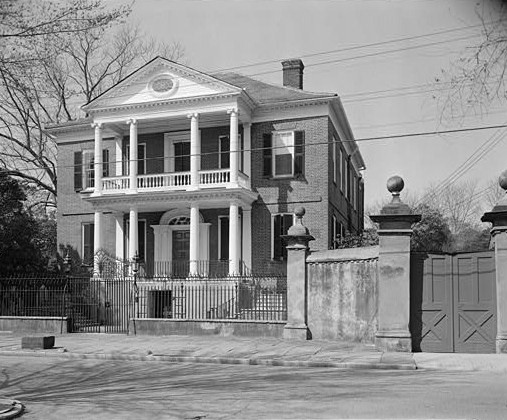
The William Brewton house, 1769, illustrates the city's wealth and refinement during the Colonial era.
William Charles was born into a world of conflict. Though Charleston was quiet for the moment, to the north Colonel George Washington was conducting a grinding defense of the Virginia frontier against French-allied Indian raiders; across the Atlantic, chief British ally Frederick the Great was fighting for Prussia’s political life against the Austrians, French and Russians; and on the other side of the globe, Robert Clive was conquering India for the British Crown, and its commercial creature, the East India Company. All these were phases of the Seven Years War, a near-global conflict whose chief principals were England and France.
The world of ideas, too, knew conflict and change. Although Newton’s physics had triumphed, its implications still troubled Continental philosophers—and at least one English poet, William Blake. Born, like Wells, in 1757, he would write:
. . . and Newton’s particles of light
Are sands upon the Red Sea shore,
Where Israel’s tents do shine so bright.
Mathematically-based physical analysis continued to advance nevertheless, untroubled by poetic scruples. For example, in 1757 Leonhard Euler published his equations of inviscid fluid flow; Daniel Bernoulli and Joseph-Louis Lagrange were also making valuable contributions around this time.
Chemistry, on the other hand, had yet to emerge in anything resembling its modern form. Its nominal “father,” Antoine Lavoisier, was a mere lad of fourteen, and the last proponent of the old phlogiston theory, experimentalist and clergyman Joseph Priestly, had not yet turned his attention to the discipline. The nature of matter and of heat still remained largely mysterious—though chemist and physician Joseph Black, who would go on to deduce the principle of latent heat, received his appointment at the University of Glasgow in 1757. (He was also the discoverer of "fixed air"--the gas we now call "carbon dioxide"--back in 1753.)
Young William Charles Wells would soon receive exposure to such ideas, for before his eleventh birthday, he was sent to school back in Dumfries, his parents’ former home. Completing his studies there in 1770, he then attended “several of the lower classes” at the University of Edinburgh. Apprenticeship to Dr. Alexander Garden, a Charleston physician and naturalist, followed. Wells later said that he had learned more during this time than during any other period of his life—albeit not due so much to his master’s instruction as to sheer hard study.
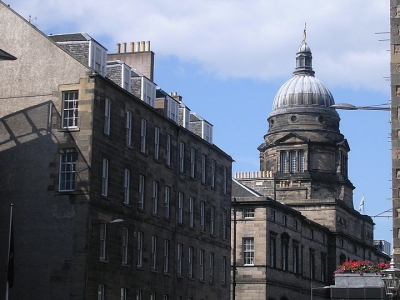
A view of the 1887 Old College dome, University of Edinburgh. (Unfortunately, there is no surviving image of the Old College building Wells knew--nor of Wells himself, for that matter.)
But by 1775, William’s loyalty to the British Crown had placed him in a difficult position with partisans of the nascent Revolution. He returned to the University of Edinburgh, and studied medicine further in London. In 1779 he briefly took work as surgeon to a Scottish regiment in Holland, and then studied at the University in Leyden. A dissertation—significantly entitled On Cold—was the final requirement for his degree as Doctor of Medicine, received from the University of Edinburgh in 1780.
There followed a period replete with colorful American adventures—tempting to relate in detail, but less than relevant to our purpose. Briefly, Wells shuttled between Charleston and Saint Augustine, Florida, according to the political ebb and flow. In Charleston he was:
. . . at the same time an officer in a corps of volunteers; a printer, a bookseller, and a merchant, a trustee for some of his father’s friends in England for the management of affairs of considerable importance in Carolina; and on one occasion. . . Judge Advocate.
(He won the case.)
In St. Augustine, he edited the first newspaper published in Florida—having had to rebuild the press himself—and served again as captain of a corps of volunteers, and as manager and sometime actor in a theatrical fund-raiser for impoverished Loyalist refugees:
He had great success [as] Lusignan in Zara, and [as] Old Norval in Douglas; but did not succeed [as] Castalio in The Orphan, and failed, as might be expected by those who knew him, in Comedy.
This period was capped by false imprisonment in Charleston and shipwreck on the return voyage to St. Augustine—Wells saved himself by swimming ashore in the middle of the night.
From 1784 Wells settled in London; further wanderings were limited to a three-month Paris trip in 1785. Wells set out to establish his own practice, and to write a modest but steady stream of scholarly papers, mostly upon medical topics. Professional progress was slow at first, but he gradually established a secure, if modest, living.
Scholarly Career
Wells was a good scholar—acute in observation and careful and incisive in analysis. But he remained something of an outsider, and his work was not very influential in his day. Modern writers have favorably noted his work in nephrology (where he wholly anticipated the work of Dr. Bright) and optical physiology (an area seeing him involved in controversy with no less than Erasmus Darwin.) And Wells was credited with an important insight by no less an authority than Erasmus’s more famous grandson. Charles Darwin would write that Wells:
…distinctly recognizes the principle of natural selection, and this is the first recognition which has been indicated...
The main exception to Wells’ scholarly obscurity was his Essay On Dew. It would bring Wells, if not fortune, then at least a measure of fame, when it won the Royal Society’s 5th Rumford medal. The origins, nature, and properties of dew were subject to much confusion in 1811; Aristotle’s millennially-old ideas were still influential.
Knowledge of Dew: Before and After Wells
An amusing though fanciful illustration of the prevailing lack of knowledge comes from a 1657 satire, A Voyage to the Moon:
I planted my self in the middle of a great many Glasses full of Dew, tied fast about me; upon which the Sun so violently darted his Rays, that the Heat, which attracted them, as it does the thickest clouds, carried me up so high, that at length I found my self above the middle Region of the Air.
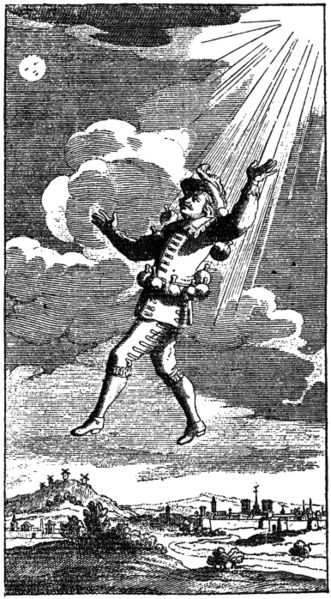
Ascending by the magical power of dew, from a 1657 illustration.
The author? Cyrano de Bergerac, best known today as protagonist of Edmund Rostand’s 1891 play. An admirer of Descartes, the historical Cyrano evidently envisioned the supposed rising of the dew from the earth as caused by Solar attraction. It was a natural imaginative step for the nimble-minded Cyrano to apply this conjectural force as a lifting agent!
Wells was imaginative in quite a different way. Pursuing one experimental tack after another, he laboriously arrived at the truth that dew was essentially a consequence of radiational chilling. As he states in the second part of On Dew:
. . . dew appears in an open and level grass field during a still and serene night. The upper parts of the grass radiate their heat into regions of empty space, which consequently send back no heat in return; its lower parts, from the smallness of their conducting power, transmit little of the earth’s heat to the upper parts, which, at the same time, receiving only a small quantity from the atmosphere, and none from any other lateral body, must remain colder than the air, and condense into dew its watery vapour, if this be sufficiently abundant. . .
Previous authors had noted an association of cold and dew. But Wells realized that cold was the cause and dew, the effect: “The formation of dew, indeed, not only does not produce cold, but like every other precipitation of water from the atmosphere, produces heat.”
Larger issues
1. Thermodynamics.
In tracing the mechanism of the production of dew, Wells arrived at important concepts—concepts new enough to lack terms. The term “humidity” did not exist; Wells must perforce say “the existing state of the air in regard to moisture.” Nor was there such a term as “thermodynamics.” Yet Wells is clearly grappling with thermodynamic concepts when he describes an old “experiment which has been used to prove the reflection of cold”:
. . .the bulb of a thermometer [is] placed before a larger cold body. . . In this situation the small body radiates heat to the larger, without receiving an equivalent from it, and, in consequence, becomes colder than the air through which its heat is sent, notwithstanding that it is continually gaining some heat, both from the air which surrounds it and from the walls and contents of the apartment in which the experiment is made.
Note that Wells describes this experiment, possibly performed as early as 1665, in essentially modern terms: radiation passes between two bodies at unequal temperatures, producing a net flow from warmer to cooler—yet the warmer body is cooler than it otherwise would have been.
Wells identifies the same dynamic at work in interchanges between atmosphere and the surface of the Earth:
Radiation of heat by the earth to the heavens must exist at all times; but, if the sun be at some height above the horizon. . . the heat emitted by it to the earth will overbalance, even in places shaded from its direct beams, that which the earth radiates upwards.
2. Surface Heat Budget.
Wells continues:
In a calm and serene night, however, when consequently little impediment exist to the escape by radiation of the earth’s heat to the heavens, and when no heat can be radiated by the sun to the place of observation, an immense degree of cold would occur on the ground, if the following circumstances did not combine to lessen it. 1. The incapacity of all bodies to prevent entirely the passing of heat by conduction from the earth to substances placed upon them. 2. The heat radiated to these substances by lateral objects. 3. The heat communicated to the same substances by the air. 4. The heat which is evolved during the condensation of the watery vapour of the atmosphere into dew.
In essence—though he lacks the term—Wells is outlining a “surface heat budget.” He continues by considering the most obvious atmospheric “impediment,” clouds:
No direct experiments can be made to ascertain the manner in which clouds prevent or occasion to be small the appearance of a cold at night upon the surface of the earth greater than that of the atmosphere; but it may, I think, be firmly concluded, from what has been said in the preceding article, that they produce this effect, almost entirely by radiating heat to the earth in return for that which they intercept in its progress from the earth towards the heavens...
Shivering in the garden, Wells had frequently measured warming when sudden cloud blew in—or the reverse, when the sky cleared.
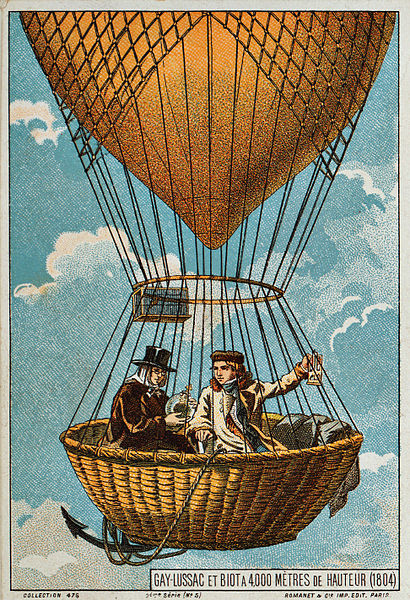
Gay-Lussac and Biot making observations during their 1804 flight.
3. Lapse rate.
Wells then shows his awareness of what we now term the “lapse rate.” (By 1811, the year Wells began his researches on dew in earnest, a number of balloon flights had been made in part to measure temperature and humidity.) More, he draws an important consequence:
Dense clouds near the earth must possess the same heat as the lower atmosphere, and will therefore send to the earth, as much, or nearly as much heat as they receive from it by radiation. But similarly dense clouds, if very high, though they equally intercept the communication of the earth with the sky, yet being, from their elevated situation, colder than the earth, will radiate to it less heat than they receive from it, and may, consequently, admit of bodies on its surface becoming several degrees colder than the air.
4. Frost hollows and temperature inversions.
Wells then notes a phenomenon now sometimes termed the ”frost hollow:”
There is a remark by Theophrastus, which has been confirmed by other writers, that the hurtful effects of cold occur chiefly in hollow places. . .
Some of those balloon flights had observed not only normal lapse rates, but also what we now call “temperature inversions.” Wells analyzes how inversions could occur:
Let it be supposed then, that while the earth in this [warmed] state, radiates upwards a quantity of heat, a foot in depth of the incumbent air is capable of stopping a 1000th of what it hence receives, and of converting it into heat of temperature. The consequence must be that the next foot, from receiving only 999 parts of what had been emitted by the earth, will not be so much heated as the first foot, though it should absorb the same proportional quantity of what enters it. In this way every successive foot will acquire a less quantity of heat than the preceding. . .[Therefore] the heat of the air in a clear and calm night ought to increase [editorial emphasis]. . . in some decreasing geometrical ratio as the atmosphere ascends. .
Compare a popular modern source, Wikipedia, on this topic:
An inversion is also produced whenever radiation from the surface of the earth exceeds the amount of radiation received from the sun, which commonly occurs at night . . .
Wells applies this principle to the situation of a hill with an adjacent plain, concluding that temperature differentials of 10 degrees (F) are quite plausible. Moreover, the effects of differential wind speeds upon the heights and the plain will tend to amplify this radiationally produced effect.
Returning to the “frost hollow” and its converse, the elevated plain, and to the topic of dew, Wells observes that:
An explanation may be now easily given of an observation by Mr. Jefferson, of Virginia, which, however, had also been made by Aristotle and Plutarch, that dew is much less copious on hills than it is upon plains. . . as the production of dew must be in proportion to the whole depression of the temperature of the air which furnishes it. . . it may readily be inferred that dew shall sometimes be altogether wanting on a hill, though abundant on a plain at its foot, agreeably to what has been actually observed by Mr. Jefferson.
(American readers may take a moment to bask in the Presidential scientific citation.)
Related Practicalities: Windows, Roofs, Food and Ice
Wells concludes On Dew with discussions of practical consequences and applications of the principles of radiational cooling. He notes and explains differential dew formation upon interior surfaces of windows, shrewdly noting that what we today call “relative humidity” is the key:
The air of the chamber had once been a portion of the external atmosphere, and had afterwards been heated, when it could receive little accession to its original moisture. It consequently required being cooled considerably, before it was even brought back to its former nearness to repletion with water; whereas the whole external air is commonly, at night, nearly replete with moisture, and therefore readily precipitates dew on bodies only a little colder than itself.
He discusses the radiational cooling effect of sleeping on roofs, an inveterate habit in tropical climes. He examines the protection of plants from frost:
I had often, in the pride of half knowledge, smiled at the means frequently employed by gardeners to protect tender plants from cold, as it appeared to me impossible that a thin mat, or an such flimsy substance, could prevent them from attaining the temperature of the atmosphere, by which alone I thought them liable to be injured. But, when I had learned that bodies on the surface of the earth become, during a still and serene night, colder than the atmosphere, by radiating their heat to the heavens, I perceived immediately a just reason for the practice, which I had before deemed useless.
Wells even examined the idea, found alike in ancient and folk sources, that moonlight exerted a putrefying influence upon “animal substances.” Although the “bare mention of the subject. . . will be apt to excite ridicule,” Wells went on to suggest that the belief may in fact have a kernel of truth: dew is apt to accompany moonlight, since both are associated with clear nights. Therefore it is possible that any “animal substances” which are allowed to become thoroughly bedewed will indeed be prone to spoil—albeit from moisture, not exposure to moonlight.
The final (and most extended) discussion of an application of radiational cooling is a fascinating one. It seems that Bengalis had invented a method to manufacture ice by radiational cooling. Two authors, Sir Robert Barker and a certain Mr. Williams, had written accounts of the practice.

Bengali ice-making, as described by Sir Robert Barker, 1775.
According to their descriptions, shallow pits were dug in open ground, and the bottoms of these pits were insulated with dry straw. Shallow unglazed earthenware pans, filled with boiled water, were exposed to the night sky on cold (but, in Bengal, not sub-freezing) nights. Radiational cooling would cause the water to freeze. The resulting discs of ice were slipped out of the pans, and could presumably be sold or stored for later use.
Both authors, and the great Sir Humphrey Davy, who commented upon their reports, believed that evaporative cooling played a great part in the cooling of the water. Wells ascribed the effect entirely to radiation. He argued his case skillfully and convincingly, considering quite minutely all the circumstances Barker and Williams mention. But as with the other practical applications discussed in Part Three, he does not neglect to experiment himself:
While attending to this subject, I became desirous of acquiring some knowledge of the degree of cold which might be produced by evaporation from water contained in a shallow vessel. With this view I placed on a featherbed, situated between the door and window of a room in my house in London, two china plates, into one of which as much water was poured, as covered its bottom to the depth of a quarter of an inch. The other plate was kept dry. The bulb of a small thermometer being then applied to the inside of the bottom of each plate, I observed upon many days, in various seasons of the year, the difference between these instruments while the door and window were open. I found, in consequence, that when the temperature of the air in the room was 75o. . . the thermometer in the plate containing water, was between 6 and 7 degrees lower than the one in the dry plate; that the difference between these thermometers diminished gradually as the air became colder; and that when the temperature of the air was 40o, the lowest for which I have any observation, the difference was only 1o1/2. At 32o, therefore, it would have been very small. . .
Moreover, Wells had no difficulty in making ice in glazed vessels. Since such vessels are impermeable, once the first film of ice has formed upon the surface of the water no further evaporation could take place. Yet freezing continued to completion in these vessels, as in all others.
Conclusions
Part Three brings On Dew to a close. Wells tells us that his investigations were brought to a premature conclusion by his declining health: he could no longer labor deep into the night and still attend to his medical practice. Unfortunately, his health continued its gradual decline; he would die, peacefully, of apparent heart failure, on September 18th, 1817.
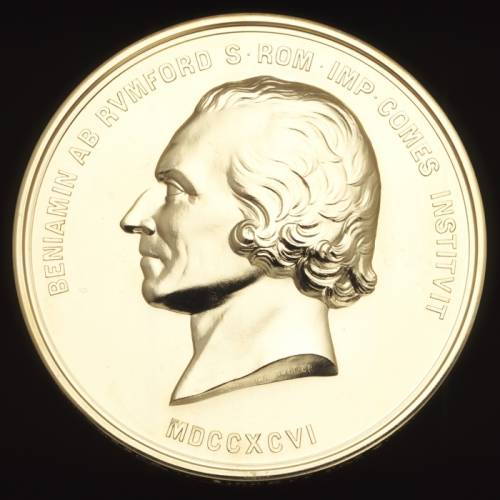
A modern Rumford medal.
Among his belongings was the cherished Rumford Medal. Perhaps it’s appropriate, then, to make our final appreciation of On Dew by quoting the eloquent words of the 23rd Rumford Medal winner—John Tyndall:
With broken health Wells pursued and completed this beautiful investigation; and, on the brink of the grave, he composed his Essay. It is a model of wise enquiry and of lucid exposition. He made no haste, but he took no rest till he had mastered his subject, looking steadfastly into it until it became transparent to his gaze. Thus he solved his problem, and stated its solution in a fashion which renders his work imperishable.Since his time various experimenters have occupied themselves with the question of nocturnal radiation; but, though valuable facts have been accumulated, if we except a supplement contributed by Melloni, nothing of importance has been added to the theory of Wells.































 Arguments
Arguments























 0
0  0
0






Comments